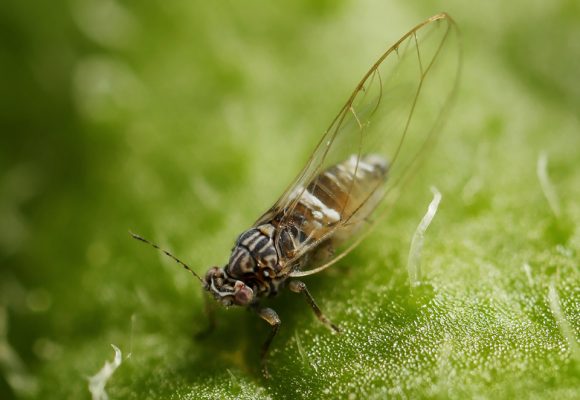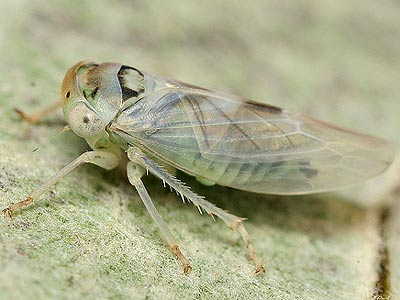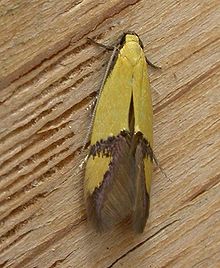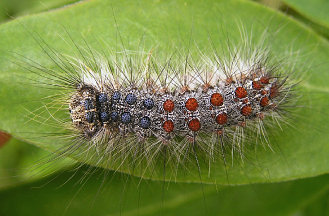Ordinary pistachio psyllids are the most important pistachio pest, which gardeners call dry sap. Because the honey excreted from the end of the body of the purees of this pest dries up in front of the air, it turns into round seeds that fall on the leaves and under the tree. |
Ordinary pistachio psyllids
Ordinary pistachio psyllids are the most important pistachio pest, which gardeners call dry sap. Because the honey excreted from the end of the body of the purees of this pest dries up in front of the air, it turns into round seeds that fall on the leaves and under the tree. It spends the winter as a full-fledged insect and usually lays its eggs in early May. And its babies are fed on vegetable sap to become adult insects. pistachio psyllids are small insects that range in size from 1.5 to 1.8 millimeters in size. Its abdomen is usually the color of its body and often has brownish brown spots that appear circular around the abdomen. The wings of this insect are yellow and have brown spots, and their distances are relatively regular.

Figure1-pistachio
-
Damage to ordinary pistachio psyllids
When the pistachio juice is absorbed by the common pistachio psyllid, its brain weight decreases, the percentage of emptiness increases, and the amount of laughter decreases. The pest is weakened and sometimes burnt brown spots are seen on the leaves. Other harms of this pest include the fall of leaves and fruit buds the following year and the closure of air vents due to the secretion of honey.
-
Methods of combating dry sap in pistachio
The natural way to control the population of this pest are its predators, including ladybugs and several species of small bees. In less sprayed orchards, these predators automatically keep the pest low in the population. One of the artificial and non-chemical methods of combating psyllid pests is the use of yellow and sticky traps that can attract a number of insects. And it is more recommended in small enclosed gardens where the density of trees is low. The presence of wind and dust reduces the efficiency of this trap. If you have a large population of insects, you can use one of the following toxins:
- Amitraz or MitaK in a ratio of 1 to 1.5 per thousand
- Consolation ratio of 0.5 per thousand
- Confides ratio is 0.4 per thousand
- Darton in a ratio of 2.5 per thousand
To use chemical pesticides and to determine the time of spraying, it is recommended that when there are on average 10 to 50 leaf purees on 50% of the leaves of garden trees.
pistachio cicadellidae
In pistachio growing areas, this pest is called sap. The pistachio cicadellidae has only one generation per year and spends the winter as a complete insect under the bark and crevices of pistachio tree trunks or other trees such as almonds, apricots and in the cracks of old walls near pistachio orchards. It starts operating in warmer climates in mid-March and in colder climates in early April.

Figure2-pistachio
-
Pest damage of pistachio
From the insect bites to the young fruit pericarp, vegetable sap comes out and at the same time the droppings and secretions of the nymphs fall on the leaves and clusters. In addition to burning leaves and clusters, these secretions also create a negative environment for the growth and appearance of saprophytic fungi. And most infected trees get soot or fumagina. The result is that the fruits gradually dry out and wrinkle. Sometimes the damage is so great that no healthy fruit remains on the tree. One of the easiest ways to detect pistachio cicadellidaes in the garden is to gently place one hand under the young clusters and hit the cluster quickly and gently with the other hand, if small insects flying fast are seen in the hand. Most likely the tree is contaminated with cicadellidaes.
-
A battle- pistachio
Chemical control should begin at the time of bud emergence before spawning and end as soon as the trees begin to flower. If insect control is not done before flowering, wait for the nymphs to appear and then proceed with the chemical control. Phosphorus or dimethoate toxins or endosulfan toxins can be used in a ratio of 2 per thousand to fight.
pistachio wood eating butterfly or Kermania Pistacchiella
This pest is currently one of the most important pests in pistachiogrowing areas in the country. The extent of this pest has been extensive and has been observed in pistachio cultivation in Kerman, Fars, Damghan, Yazd, Qazvin, Khorasan, Sistan and Baluchistan and other parts of Iran. The complete insect of this pest is a butterfly. Small, with a width of about 11 to 13 mm with open wings. The general color of the body and its wings are dark glossy and covered with scales. On the front wings, two yellow spots are seen, one larger and in the middle and the other smaller and at the end of the wing. This pest spends the winter completely inside pistachio branches. At the end of winter, when it emerges from the pistachio branches, on the branches and near the buds or on the trunk and even on the clumps on the garden surface, it begins to weave a cocoon in the shape of an inverted boat and becomes a pupa.

Figure3-pistachio
-
How to damage pistachio woodpecker butterfly
The pupal stage is about 25 to 30 days. Pest butterflies emerge from the cocoons during this period and mate with each other. The female butterflies then spawn on the heads of the young branches, the axis of the clusters, the tail of the fruit and even the tail of the leaves. After the incubation period, the eggs hatch and the larvae of the first age enter the plant from the place of attachment of the egg and reach the center of the cluster or the head of the branch and feed on this place. They leave brown and black droppings at the feeding site. The larvae inside the cluster axis cause the clusters to fall at the beginning of the season. But if the cluster has grown, only a few of the end fruits of the clusters will fall around the middle of the dry and blackened lunar month.
The larvae located in the brain of the head of the branches weaken the head of the branches and as a result weaken the fruit buds and leaves the following year. This insect has one generation per year, and due to the fact that it spends most of its life in the core of the clusters and branches, it is difficult to fight and the duration of the fight against the pest is short, so it is recommended to fight it. Enough attention. Today, the maximum emergence and flight of pest licenses is determined using pheromone traps, and thus the time to fight the pest is more accurately determined and communicated to farmers. Therefore, it is recommended that you consult with relevant experts to find out when to fight. If necessary, the larval insecticide or tudikarb can be used at a rate of 1.5 kg per thousand liters of water, one week after the maximum butterflies. This time coincides with the time when the female flowers were inoculated and the seeds were milled. Like many pistachio pests, this pest has many natural enemies and parasitic bees that play an important role in lowering the pest population each year.
 Figure4-pistachio
Figure4-pistachio
pistachio fruit eating butterfly
This winter pest lives as a complete larva under the bark of old pistachio tree trunks and becomes pupae and then butterflies in late March. The emergence of full grown insects occurs in mid-April and coincides with the swelling of the buds, which spawn after mating on the newly formed flowers and fruits. The eggs hatch about two weeks later, and the young, milky larvae penetrate the newly formed fruit. And they feed on the fetus. Infected fruits at this stage, before the hardening of the bony skin, turn black and dry due to the feeding of the larvae, and eventually fall off.
After eating the contents of the fruit, the larvae pierce and remove the fruit, and then enter the next fruit, at which point each larva is able to destroy 8 fruits. After changing the skin several times, the larvae turn into pupae and then complete insects under the bark of tree branches and trunks. The second generation of the pest usually begins on July 20 to August 20, and the butterfly lays eggs on large, pistachioseeds. After the eggs hatch, the larvae hatch under the green pistachio kernels. And they feed on the inner surface of the green skin, or enter the fruit through the cleft of the bony skin or the place where the pistachio smiles, and feed on the brain of the fruit. By leaving the larval debris on the bone skin, they cause dark spots on it.
-
A battle- pistachio
The time to fight against pistachio fruit eating butterflies in orchards that have a history of contamination is when about 2.3 flowers have become fruit. In order to fight against this pest, chemical control methods can also be used. In order to use it, it is necessary to consult with a plant protection expert about determining and determining the amount of toxins required.
pistachio leaf eater or Rae
pistachio leaf eating butterfly or white leaf eating butterfly, also known as Rao, is one of the most important pests of pistachio orchards in Iran. This pest spends the winter in a shelter and in different shelters. The time of activity of pistachio leaf eating butterfly in Kerman province is from early May onwards. If you are in an area of this pest, you can see butterfly eggs in the bundles of 50 or more clusters attached to the back surface from the beginning of May.

Figure5-pistachio
-
Damage of pistachio
The damage of this pest is such that the butterfly larvae, after hatching, feed directly on the leaf parenchyma and the upper epidermis, and the larvae of later ages eat most of the leaf petioles and leave only the main veins.
-
Time and methods of combating pistachio leaf eater
pistachio or Rao leaf eating butterfly is one of the pests whose population can be well controlled. Although a number of pest larvae are eaten by spiders and small birds due to the large size of the larvae, if the garden is seriously endangered by the pest, the following toxins can be used to repel them, and if the number of leaves eaten is not high, spraying is required is not. Because spraying against other pests at any time will eliminate this pest in the garden. The toxins that can be used against pistachio leaf lice are as follows:
- Zolon or Fozalon in the ratio of 2 to 2.5 per thousand
- Diazinon in a ratio of 2 to 2.5 per thousand
-
Krash in pistachio
pistachio butterfly is called in the local term krash. The host of this pest is pistachio. In winter, it is pupae on the dried shells and leaves of pistachio trees and in the layer of lumps under the trees.
-
Damage of pistachio
The larvae of this pest feed on the first generation of small pistachio seeds in May and June and cause damage similar to the damage of pistachio fruit eating butterflies. The next generation of larvae feed on the green skin of the fruit, and as a result, the seedless, brainless seed remains dried and shed. In the last generation, which coincides with the ripening of fruits, pest larvae feed on the soft skin of pistachios and cause dark spots on the bony skin of pistachio seeds, which reduces the popularity and quality of pistachios in the market.
-
A battle- pistachio
If this pest spreads in an area, it is necessary to fight its small larvae at the beginning of the season, that is, in May to June. Because if the larvae start weaving the thread, the effect of the poison on them will be reduced. One of the following toxins can be used to control this pest:
- Zulus in a ratio of 1.5 per thousand
- Malathion in a ratio of 2 per thousand
